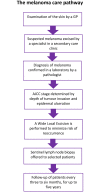Health professional and patient views of a novel prognostic test for melanoma: A theoretically informed qualitative study
- PMID: 35377887
- PMCID: PMC8979436
- DOI: 10.1371/journal.pone.0265048
Health professional and patient views of a novel prognostic test for melanoma: A theoretically informed qualitative study
Abstract
Objectives: Cutaneous melanoma rates are steadily increasing. Up to 20% of patients diagnosed with AJCC Stage I/II melanomas will develop metastatic disease. To date there are no consistently reliable means to accurately identify truly high versus low-risk patient subpopulations. There is hence an urgent need for more accurate prediction of prognosis to determine appropriate clinical management. Validation of a novel prognostic test based on the immunohistochemical expression of two protein biomarkers in the epidermal microenvironment of primary melanomas was undertaken; loss of these biomarkers had previously been shown to be associated with a higher risk of recurrence or metastasis. A parallel qualitative study exploring secondary care health professional and patient views of the test was undertaken and this paper reports the perceived barriers and enablers to its implementation into the melanoma care pathway.
Methods: Qualitative methods were employed drawing upon the Theoretical Domains Framework (TDF) in the exploration and analysis. An inductive-deductive analysis was performed, with all data coded using a thematic then TDF framework.
Findings: 20 dermatologists, plastic surgeons, cancer nurse specialists, oncologists and histopathologists participated. Nine TDF domains were relevant to all health professional groups and the 'Skills' and 'Beliefs about Capabilities' domains were relevant only to histopathologists. 'Optimism' and 'Beliefs about consequences' were strong enablers particularly for clinicians. 'Environmental context and resources' (impact on pathology services) and 'Knowledge' (the need for robust evidence about the test reliability) were the main perceived barriers. 19 patients and one carer were interviewed. For the patients eight domains were relevant. ('Knowledge', 'Emotions', 'Beliefs about consequences', 'Social Role and identity', 'Behavioural regulation', 'Memory, attention and decision processes', 'Reinforcement' and 'Skills'). The consequences of the implementation of the test were reassurance about future risk, changes to the follow-up pathway on which there were mixed views, and the need to ensure they maintained self-surveillance (Beliefs about consequences). The test was acceptable to all patient interviewees but the resultant changes to management would need to be supported by mechanisms for fast-track back into the clinic, further information on self-surveillance and clear management plans at the time the result is conveyed (Behavioural regulation).
Conclusions: Health professionals and patients perceived positive consequences-for patients and for health services-of adopting the test. However, its implementation would require exploration of the resource implications for pathology services, psychological support for patients with a high-risk test result and mechanisms to reassure and support patients should the test lead to reduced frequency or duration of follow-up. Exploring implementation at an early stage with health professionals presented challenges related to the provision of specific details of the test and its validation.
Conflict of interest statement
I have read the journal’s policy and the authors of this manuscript have the following competing interests: ML is employed fulltime as the CEO of AMLo Biosciences. RAE, ML and PL are shareholders in AMLo Biosciences. PL is employed part-time as Chief Scientific Officer with AMLo Biosciences. AMLo Biosciences hold the patents for the test.
Figures
Similar articles
-
Validation of the theoretical domains framework for use in behaviour change and implementation research.Implement Sci. 2012 Apr 24;7:37. doi: 10.1186/1748-5908-7-37. Implement Sci. 2012. PMID: 22530986 Free PMC article.
-
A pre-post evaluation of a knowledge translation capacity-building intervention.Aust Occup Ther J. 2018 Dec;65(6):479-493. doi: 10.1111/1440-1630.12483. Epub 2018 May 31. Aust Occup Ther J. 2018. PMID: 29851092
-
Barriers and facilitators to implementing the CURE stop smoking project: a qualitative study.BMC Health Serv Res. 2021 May 20;21(1):481. doi: 10.1186/s12913-021-06504-2. BMC Health Serv Res. 2021. PMID: 34016109 Free PMC article.
-
Application of the theoretical domains framework to identify factors influencing catch-up HPV vaccinations among male college students in the United States: A review of evidence and recommendations.Vaccine. 2023 May 26;41(23):3564-3576. doi: 10.1016/j.vaccine.2023.04.071. Epub 2023 May 8. Vaccine. 2023. PMID: 37164820 Review.
-
Optimising antimicrobial stewardship interventions in English primary care: a behavioural analysis of qualitative and intervention studies.BMJ Open. 2020 Dec 17;10(12):e039284. doi: 10.1136/bmjopen-2020-039284. BMJ Open. 2020. PMID: 33334829 Free PMC article. Review.
References
-
- Cancer Research UK, Melanoma Cancer Statistics https://www.cancerresearchuk.org/health-professional/cancer-statistics/s... Accessed November 2020.
-
- National Institute for Health and Care Excellence. Melanoma: assessment and management. NICE guideline [NG14]. (2015). - PubMed
Publication types
MeSH terms
Grants and funding
LinkOut - more resources
Full Text Sources
Medical




